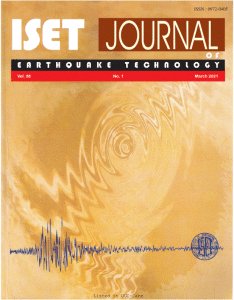Home > Issues & Journals
FLOOD ELEVATION, INUNDATION DISTANCE AND FLOW COMPETENCE OF THE 2004 SUMATRA-ANDAMAN TSUNAMI, AS RECORDED BY TSUNAMI DEPOSITS IN THIRTEEN SHORE-NORMAL PROFILES FROM THE TAMIL NADU COASTLINE, INDIA
Curt Peterson, Harry Yeh, R.K. Chadha, G. Latha and Toshitaka Katada
Paper No.: 458
|
Vol.: 42
|
No.: 4
|
December, 2005
|
pp. 95-110

Abstract
Thirteen shore-normal profiles in South-East India have been surveyed for tsunami deposit evidence ofrun-up height, flow depth, inundation distance, flow competence, and flow direction from the December 26Sumatra-Andaman tsunami. Mud lines on buildings were surveyed into timed tide level (swash zone) toestablish maximum still-water height, which ranged from 2.3 to 4.4 m mean tide level (MTL). Hanging debrisand structural damage were used to establish maximum surge heights of 3.9 to 6 m MTL. Differences betweenmaximum surge height and ground surface yielded flow depths of 1.2 to 3.2 m. Landward flow directions, asrecorded by vegetation flop-overs, sand ripples, and debris shields averaged 250°N yielding an oblique waveattack of 30-40° in central study area. Maximum inundation distances of gravel, i.e., shore-normal distancefrom mid-swash zone, ranged from 30 to 60 m. Maximum sand transport ranged from 90 to 400 m in distancefrom the shoreline. Sand sheet deposits ranged from 1 to 30 cm in thickness, and included internalstratification, rare pebble and shell clasts. Maximum tsunami flood inundation, based on transported flotsam,ranged from 140 to 800 m in shore-normal distance. Flotsam transport exceeded sand transport by between 15and 50% of maximum inundation distance in nine profiles. These preliminary reconnaissance observationscharacterize the recent tsunami inundation from low-to-moderate forcing, i.e, maximum still water 2-4 mMTL, in the low-relief settings of the South-East India coastal plain.
Keywords: Tsunami, 2004 Sumatra-Andaman Rupture, Inundation Profiles, Deposits, Tamil Nadu
©2025. ISET. All Rights Reserved.